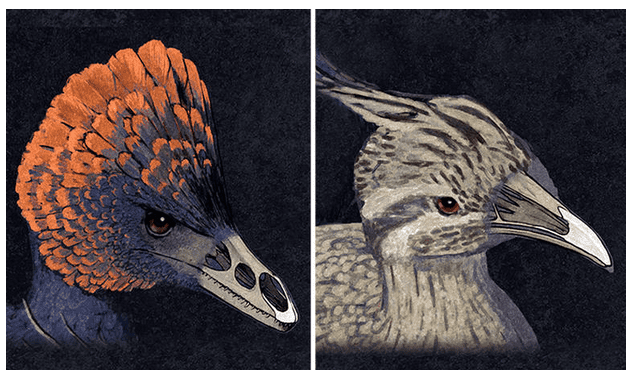Most evolutionary biologists seem to agree, based on fossil record, that the birds of today are direct descendants of dinosaurs, and that the first bird ancestors evolved some 150 million years ago. Though valuable, fossil records alone are not enough to recreate the DNA migration and tweaking that occurred to give rise to the avian family. What if you went from your original product (the bird) and genetically traced your steps backwards millions of years into the past? This is where a novel research might come in made by a collective from Harvard, Yale and several other universities. The scientists used the knowledge their garnered in eight years of research about how bird beaks form in the embryo stage to shut down key protein sequencing to basically breed birds with primitive, dinosaur-like snouts.

Birds don’t have teeth, paw, hands, antlers, horns, or spines, but they do have beaks. Also know as the bill, the bird’s beak is essentially made out of two parts: the upper and lower mandible. The upper mandible grows out of the skull, just like your upper teeth grow out of your skull, while the lower mandible can move independently, since its hinge. It’s the lower mandible the allows birds to peck or eat. In fact, feeding is the primary purpose of the beak, but many birds have adapted many other uses for it. The pelican uses its huge beak as a fishnet, the hummingbird as a sophisticated straw and the woodpeckers as a jackhammer to pick wood and discover insects.
It’s hard to imagine a bird today without a beak. It would certainly be useless and would not survive in the wild past its fledgling youth. But despite this, birds evolved beaks rather late. The earliest bird that had a beak resembling modern ones was the 85-million-year old Hesperomis and a massive international collaboration used huge gene banks to find that all birds lost their teeth some 116 million years ago. But how is the beak formed in the first place?
The study was led by Bhart-Anjan Bhullar of Yale University and Arhat Abzhanov of Harvard University who have been studying everything they could get their hands on about bird’s beak formation and evolution. The most comprehensive literature deals with chickens, the most abundant bird on the planet and a major source of food for humans. Apparently, even before the chicken embryo grows what we could recognize as a face, a large patch of cells releases proteins called Fgf8. Later, the same region produces another protein called Lef1. Mice, turtles, lizards and crocodiles also express these proteins in the face region, but only in small patches, whereas the chicken and emu (both birds) grow the proteins in a single large patch.
This looked like a pattern, so Bhullar and Abzhanov interfered with embryo development by releasing chemicals that inhibited Lef1 and Fgf8 growth. As expected, the chicken embryos failed to develop beaks, and instead grew a pair of round, unfused bones. This was very much akin to a dinosaur snout. Did the researchers actually reverse evolution? Well, so far opinions have been mixed. The study abstract reads:
“The avian beak is a key evolutionary innovation whose flexibility has permitted birds to diversify into a range of disparate ecological niches. We approached the problem of the mechanism behind this innovation using an approach bridging paleontology, comparative anatomy, and experimental developmental biology. First we used fossil and extant data to show the beak is distinctive in consisting of fused premaxillae that are geometrically distinct from those of ancestral archosaurs. To elucidate underlying developmental mechanisms, we examined candidate gene expression domains in the embryonic face: the earlier frontonasal ectodermal zone (FEZ) and the later midfacial Wnt-responsive region, in birds and several reptiles. This permitted the identification of an autapomorphic median gene expression region in Aves. In order to test the mechanism, we used inhibitors of both pathways to replicate in chicken the ancestral amniote expression. Altering the FEZ altered later Wnt responsiveness to the ancestral pattern. Skeletal phenotypes from both types of experiments had premaxillae that clustered geometrically with ancestral fossil forms instead of beaked birds. The palatal region was also altered to a more ancestral phenotype. This is consistent with the fossil record and with the tight functional association of avian premaxillae and palate in forming a kinetic beak.”
Speaking for the New York Times, Ralph S. Marcucio, a developmental biologist at the University of California, San Francisco said the inhibitors used by the researchers are toxic. As such, the altered anatomy of the chicken embryos might not be a display of reversed evolution; just dying tissue. He also has doubts as to how important these meager proteins might be for full-on beak development.
“It really makes me suspicious that it’s not involved in some kind of switch,” he said.
“It’s a simple kind of thing, but when you look at the actual pieces of data, it tends to fall apart,” he said. “It takes away from the complexity that’s the reality.”
Dr. Marcucio believes that in reality the whole story is much more complex, but acknowledges that the research is definitely promising, though far from being the last word. I guess we’ll just have to wait and see how the same method the researchers used fairs against other animal groups. Namely, use the same process for other species or groups altogether and see whether you can get this sort of faux evolutionary reversal. The findings were published in the journal Evolution.
Was this helpful?



